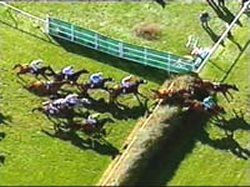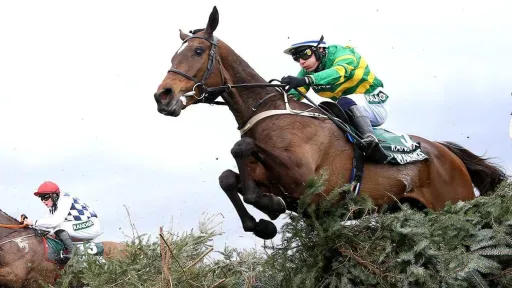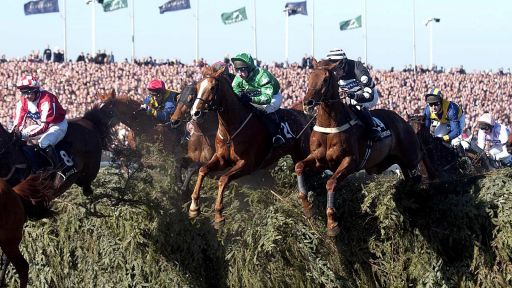The World's Greatest Steeplechase

The Grand National Horse Race is often called the world's greatest steeplechase.
 The race is one of the most famous steeplechases in the world. It is a unique test of horsemanship for the rider and also a test of a great significance for a horse.
The race is one of the most famous steeplechases in the world. It is a unique test of horsemanship for the rider and also a test of a great significance for a horse.
The course is nearly two and a quarter miles in length and has 16 unique fences including the famous Bechers Brook. The fences have an added problem for horses, the famous drop fences where the landing side of the fence is lower than the take off side, this means the horse approaching the fence is unaware of the drop until in the air.
At The Chair Fence the reverse of this occurs. It is the biggest fence on the course and the landing side is higher than the take off.
In the Grand National the horses have to complete almost two circuits of the course and jump 30 fences and then complete a long 494 yard run in which has been the downfall of many in the past.
There are two fences that are jumped only once and this is on the first circuit and they are the famous Chair and the water jump.
Although the first 'Official Grand National' was in 1839 the race was first run three years earlier in 1836. However the story starts sooner than that. In the mid 1820's William Lynn of the Waterloo Hotel in Liverpool was not just an innkeeper but also a entrepreneur and he sponsored a hare coursing event called the Waterloo Cup, the success of this and also the interest being shown in the flat racing being held in Merseyside gave him the idea of leasing some land in the area at Aintree and holding race meetings. With his usual energy Mr. Lynn had his plans soon underway and Lord Molyneux laid the foundation stone for the grandstand on July 7th 1829. Racing began at Aintree on the 7th of July the same year. Mr Lynn held three meetings a year however not content with this achievement in 1835 he had the idea of running a steeplechase at the Aintree course. On 29th of February 1936 he advertised the race:- A sweepstakes of 10 sovs. Each with 80sovs added, for horses of all denominations, 12st each, gentlemen riders, second horse receives back his stake. Winner to be sold for 200 sovs. if demanded.
The race was an immediate success and it was written of the race in a local journal on March 1st, "The first steeplechase ever run in the neighbourhood of Liverpool came off in enclosed ground near Aintree racecourse". The race was won by The Duke and the rider was the now famous Captain Becher . The following year the race was held in Maghull (Still in Liverpool) This race was also won by The Duke but this time was ridden by Mr Potts as Captain Becher could not get to the course as the previous day he had been riding at St Albans, of course in those days travel was slow and it was almost impossible to get to the course. This year the race was named as Grand Liverpool Steeplechase.
The following year again at Maghull was another success. The Duke was again running being ridden by captain Becher but on this occasion he finished third and the winner of the race is not clear as official records show the winner as Sir Henry however there was no horse called Sir Henry running. The race was actually won by Sir William.
The following year (1839) was to be what every official record shows as the first Grand National even though at this time it was still called the Grand Liverpool Steeplechase. The race was won by Lottery and he goes down in the history books as the first winner of the race. Captain Becher was also running that year but fell into the brook at the fence that now holds his name.
Since these early years there have been many changes and stories of The Grand National horse race. In 1839 the name of the race was changed to The Liverpool and National Handicap Steeplechase and as the name suggests the race became a handicap race.
In 1847 the race was given the title of The Grand National Handicap Steeplechase. A name it still holds today.
1850/1851 saw the first duel winner of the race when Abd-El-Kader was the winner on both occasions.
1869 was to see the first Grey winner, The Lamb who also went on to win the race three years later. This was nothing short of miraculous given that the horse had been suffering from a wasting disease in the time between these races.
1893 saw another remarkable story when a horse called Cloister won the race by 40 lengths.
In 1895 a very good horse, The Wild Man from Borneo won the race and his stuffed head is still at the course in the room that has been used to interview the winning connections. (Note in 2006 this room, the Freebooter room has been moved to the new stand complex and I am unsure if the head is still on show)
The late 1800's also saw the greatest of all horses to run in The Grand National, the duel winner Manifesto. A bay with a white star on his forehead by Man of War (by Ben Battle by Rataplan) out of Vae Victus by King Victory, was a tough well proportioned and powerful horse which was just as well as he Jointly holds the record for the highest weight carried by a wining horse that of 12st 7 lbs. He also holds the record weight for a placed horse of 12st 13 lbs. Manifesto also hold the record for the most number of runs in the race, he ran 8 times in the race.
Soon after the turn of the century it was a horse called Moifaa was the remarkable winner in 1904 when a ship brining him to the race from New Zealand was lost and the horse had to swim ashore, 50 miles it was said, to an island, he was later recovered and when on not only to run in the race but to win the race.
The outbreak of the Great War was not to stop the race and it was held at the racecourse at Gatwick now the site of one of London's busiest Airports.
The 1920's saw the introduction of Radio to the race when in 1927 the B.B.C. brought the race to it's biggest ever audience to date when Sprig was to be the victor.
The Second World War was to see the only interruption of the race. The race was not run between 1941 and 1945 and the course at this time was used for military purposes.
In 1946 as soon as the military were gone the operation was put into place for that year's race and on the 5th of April Lovely Cottage won the 1946 race.
The following year 1947 was to see the race run for the first time on a Saturday, at the request of the Prime Minister Clement Attlee, who was said to have suggested the move would be "in the interests of British industry". Caughoo was the winner that day.
Up until this time the Aintree racecourse had been owned by Lord Sefton but in 1949 he sold the course to Tophams Limited for a sum of 275,000 pounds.
In 1952 the Tophams had a dispute with the B.B.C. over the radio coverage and this lead to the family doing their own commentary of the race, if anybody is ever in any doubt that race commentary is a difficult job then a brief listen to this commentary will tell you different. It can only be described as dreadful and it was soon handed back to the professionals.
1960 was the year when the B.B.C. was to show the race "live" on Television for the first time. Merryman II won that year and the B.B.C. have been doing a great job ever since.
1963 was a year of note when the horse that came 7th, bore a very well known owners colours that of the film star Gregory Peck.
1967 saw the biggest price winner; Foinavon won the race after he was the only horse to jump a very small fence in the race. There was a great pile up at the fence and this horse ridden by John Buckingham when on to score at odds of 100/1. The fence was later named after the horse.
The late sixties and early seventies saw a good number of good horses win the race, Red Alligator ridden by Brian Fletcher, Gay Trip ridden by Pat Taffe, Well to Do ridden by G. Thorner, but it was 1973 when one of the greatest stories started. All the talk this year was of one of the greatest steeplechasers ever The great Crisp. He was to carry top weight of 12 st and this he seemed to do easily. Crisp was way out in front for a long way until caught close home with a horse carrying almost 2 st less. But history was to show that then young pretender that day would turn out to be the only horse in The Grand Nationals history win follow up his win with two others and was to become the most famous Grand National horse of all time, of course it was Red Rum.
In the 1974 Grand National, Red Rum was now the top weight with 12st to carry but he won again. He was to wait another three years to taste victory again in 1977 when he became the only three times winner of the race. Between his wins he came second twice. First in 1975 to L'escargot and then in 1976 to Rag Trade.
1977 was also another landmark year as it was to see the first ever female jockey in the race, Charlotte Brew may not be a well known name in racing today but back in 1977 she was the person all the commentators wanted to interview as she has the title as being the first Woman to ride in the Grand National.
Good winners of the 80's included Ben Nevis, Grittar, Hallo Dandy, West Tip but two horses where going to make their connections famous in this decade.
The 1981 Grand National saw a previously crocked horse making his big race entry named Aldaniti and a jockey who had recently recovered from cancer Bob Champion win the race this caused tears of joy to a whole nation of race lovers.
1983 was another landmark year when the first ever woman trainer won the race when Corbiere put Jenny Pitmans name on the role of honours.
Mr Frisk won the 1990 race on fast ground in a record time. He was also ridden by an amateur, Mr. M.Armitage.
The 1991 Grand National was to see a horse called Seagram win the race. His name was the same as the race sponsors who did not own the horse. However they were asked if they wanted to purchase the horse some time before the race but declined the offer.
In 1992 was another memorable winner. There was to be a general election in the UK and by coincidence this year saw a giant of a horse called Party Politics win.
The following year 1993 was again to be a landmark year as the race had to be declared void after a second false start was not heard by half of the jockeys who went on to complete a full circuit of the track. A number of jockeys actually did a second round and they did not know until the end of the four and a half miles that the race would be declared void for a false start. This may seem strange but around this time there were a lot of protests being held on the course and the jockeys ignored the officials trying to stop them as they thought wrongly that they were protesters. The horse that finished first that day was Esha Ness now known as the horse that won the National that never was.
The 1994 Grand National saw another famous win when top UK comedian Freddie Star's horse Miinnehoma won the race. Although Freddie was not at the course he was interviewed on the phone for the TV cameras in one of the most bizarre interviews on TV when the viewers could only here one side of the conversion that of his trainer.
The 1995 Grand National saw Jenny Pitman win the race for the second time with Royal Athlete.
The 150th running of the race in 1997 was another bizarre story when a bomb scare meant that the course had to be evacuated and the race postponed until the Monday, to allow the course to be searched. The winner on this famous occasion was Lord Gyllene.
The 1998 Grand National saw the Aintree press manager win the race with his syndicated horse Earth Summit. The race in very soft ground. Earth Summit also won the Scottish and Welsh Nationals in his career.
1999 saw a remarkable father and son win the race, Tommy Carrbury a previous winner as a jockey was the trainer, saw his son Paul partner Bobby Jo to victory.
The year 2000 race unbelievably was the same another father and son combination win when the trainer Ted Walsh saw his son Ruby win on Papillon.
2001 Saw Red Marauder win in good style in a race ran in bottomless conditions. All the horses fell with the exception of two horses the winner and the second Smarty.
The 2002 Grand National was won in good style by Bindaree who won as so many horses do, by catching a horse on the run in.
The 2003 Grand National was the turn of Monty's Pass to win the race but his win was to be overshadowed by one of his owners who had bets on the horse to win a total of over 800,000 pounds.
So there you have a brief history of the worlds greatest Steeplechase.
I'm sure there will be great stories behind all the races and we can go on and enjoy every minute of the history of the worlds greatest Steeplechase: -


